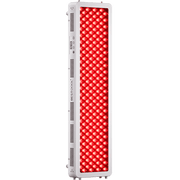Introduction
Xanthelasma is a common skin problem that often manifests as yellowish plaques around the eyelids. These lesions, despite generally being harmless, raise cosmetic concerns for many. With increasing interest in non-invasive cosmetic treatments, red light therapy has emerged as a possible solution for xanthelasma treatment. In this blog, we explore how RLT works, its application for xanthelasma, and practical considerations.
Understanding Xanthelasma
What Causes Xanthelasma?
Xanthelasma is usually associated with rising levels of cholesterol. It might point to a deeper health problem, such as heart disease. However, no known cause is attributed to xanthelasma. Genetics, age, and lifestyles, such as diet and exercise, are the contributing factors that may influence disease occurrence.

Common Concerns with Xanthelasma
- Cosmetic appearance: Many people consider xanthelasma unsightly and seek removal methods or ways to diminish their appearance. The yellowish plaques may dent the individual's self-esteem and body image.
- Potential Health Indicators: Xanthelasma can aid in the improvement of health awareness; many individuals, upon growth and development, may start screening for cholesterol and cardiovascular health.
The Role of Red Light Therapy
Mechanism of Action
Red light therapy involves mechanical penetration through particular wavelengths into the skin, which helps in cellular regeneration and reduces any form of inflammation. In fact, the therapeutic effect of red light is believed to stimulate the mitochondria - the powerhouse components of the cell. This could improve the production of ATP, which is important in cellular repair and multiplication. Phototherapy could degrade the accumulated fat that imparts a yellowish color in plaques, characteristic of xanthelasma. The anti-inflammatory effect of red light improves skin health and enhances skin texture and tone.
Applications for Xanthelasma Treatment
- Non-Invasive Approach: RLT is less invasive than surgical removal and cryotherapy. This attracts individuals who may be skeptical about undergoing more aggressive treatments. It doesn't require cuts as with the old methods of treatment. RLT does not involve low temperatures, which can be painful, and healing results in longer periods.
- Skin Health Improvement: RLT can be used to improve the overall appearance of the skin. Many users report smoother, more vibrant skin after having undergone several RLT sessions; hence, they derive extra cosmetic benefits from this treatment beyond what the mere removal of plaques themselves can provide.
Using Red Light Therapy for Xanthelasma
Recommended Protocols
- Session length and frequency: The length for each head of RLT treatment usually runs from 15-30 minutes. For optimal results, treatment is generally recommended three to four times a week. Consistency is important in reaping the best results.
- Target area: The area to be treated is the one around the eyelids. When treating sensitive skin, safety should come first, and devices intended for facial treatments must be used at all costs. Accurate treatment helps avoid damage to the surrounding skin.
Ideal Candidates
- Individuals Seeking Non-Surgical Solutions: RLT is ideal for those who do not want to take surgical or invasive measures. Any individual who is apprehensive about the complications or recovery time of the surgical alternative for his or her problem may consider RLT as an alternative solution.
- People Concerned with Skin Health: RLT can also be utilized by individuals who want to improve the appearance of their skin while treating xanthelasma. The specific effect addresses xanthelasma, and it rejuvenates vitality in the skin, therefore making it two-fold in nature.

Potential Benefits of Red Light Therapy
Reduction in Xanthelasma Appearance
Most users report that the appearance of xanthelasma improves noticeably after several courses of RLT treatments. Yellow plaques may also decolorize, thus becoming less noticeable. Results may vary according to an individual's skin type and conditions; however, positive results can usually be achieved if one proceeds with the treatment persistently.
Enhanced Skin Quality
Apart from treating xanthelasma, RLT generally contributes to healthy skin. This kind of therapy encourages collagen production, making the skin firmer and more elastic. Usually, users feel confident in their appearance because the general texture and tone of the skin begin to improve.
Practical Considerations
Safety and Side Effects
Generally, RLT is considered safe and well-tolerated; side effects are minimal for most users, aside from mild redness or warmth in the treated areas. However, it is always best to consult with a healthcare professional before starting any new treatment to ensure safety and effectiveness, especially if one has any skin conditions or sensitivities.
Choosing a Device
If you try at-home RLT yourself, then it will be great to choose a high-quality device that emits the proper wavelengths of red light. Products need to be tested for safety and effectiveness. Consult a dermatologist or skincare professional for decision guidance.
Professional Intervention Options
While at-home devices are available, many prefer to get RLT treatments from a professional. Most professional treatments involve strong devices, and the results may be faster and more apparent. You should discuss your goals and concerns with a licensed practitioner to determine the best course of action.
Conclusion
Red light therapy is a promising, non-invasive method to control xanthelasma. Many have indeed experienced success with this procedure in lessening the appearance of xanthelasma while receiving the added benefits of better skin. As with other treatments, it is always advisable to consult with a health professional for safety and effectiveness. Whether you seek cosmetic improvement or natural skin glow, red light therapy might offer a path toward your cosmetic goals.
References
- Glass G. E. (2021). Photobiomodulation: The Clinical Applications of Low-Level Light Therapy. Aesthetic surgery journal, 41(6), 723–738. https://doi.org/10.1093/asj/sjab025
- Laftah, Z., & Al-Niaimi, F. (2018). Xanthelasma: An Update on Treatment Modalities. Journal of cutaneous and aesthetic surgery, 11(1), 1–6. https://doi.org/10.4103/JCAS.JCAS_56_17
- García-Legaz Martínez, M., Martínez-Doménech, Á., Magdaleno-Tapial, J., Valenzuela-Oñate, C., Iborra-Palau, E., de Miquel, V. A., & Pérez-Ferriols, A. (2021). Treatment of Xanthoma Disseminatum With Narrowband UV-B Phototherapy. JAMA dermatology, 157(2), 235–237. https://doi.org/10.1001/jamadermatol.2020.4092














 Small
Small

 Moderate
Moderate

 Moderate
Moderate

 Moderate
Moderate

 Full
Full



